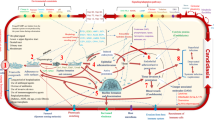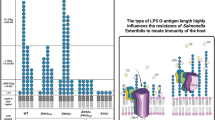Abstract
Phospholipases are important pathogenicity determinants inCandida albicans. They play a significant role in damaging cell membranes and invading host cells. High phospholipase production is correlated with an increased ability of adherence and a higher mortality rate in animal models. By means of an egg yolk-containing agar and thePz (= phospholipase activity zone) value according to Price, the present study investigated phospholipase production in 170 strains ofC. albicans. At an incubation temperature of 37 °C,Pz values ranged from 0.395 to 1; no clear relationship was found between clinical origin of the isolates and severity of the disease. In addition toC. albicans, a total of 110 strains of 16 other yeast species were investigated for possible phospholipase production. Only yeasts of the speciesRhodotorula rubra showed phospholipase activity, with mean values exceeding those observed inC. albicans. This result was confirmed by an assay using sterile culture filtrates and phosphatidyl-[3H-methyl]-choline-dipalmitoyl as a substrate. SinceRh. rubra has only rarely been demonstrated as a pathogen in humans, we believe that factors such as reduced growth at 37 °C, absence of dimorphism and low ability of adherence lessen the importance of high phospholipase activity inRh.rubra as a pathogenicity determinant. Therefore, potential virulence factors should always be considered in the context of the whole spectrum of pathogenic determinants.
Similar content being viewed by others
References
Füssle R, Biscoping J, Michaelis G, Zeiler G, Sziegoleit A. Intensive care patients: a high risk population for Candida infections. Clinical Intensive Care 1991; 2: 76–80.
Odds FC.Candida andCandidosis, a review and bibliography. 2nd ed., Leicester University Press, Leicester, 1988.
Varrtivarian SE, Anaissie EJ, Bodey GP. Emerging fungal pathogens in immunocompromised patients: classification, diagnosis and management. Clin Infect Dis 1993; 17 (Supp 2): S4870–491.
Ghannoum MA, Abu Elteen KH. Pathogenicity determinants ofCandida, a Review. Mycoses 1990; 33: 265–282.
Krempl-Lamprecht L. Factors of the pathogenicity ofCandida albicans — a review.Candida andCandidamycoses, edited by Tumbay E. et al, Plenum Press, New York, 1991.
Ibrahim AS, Mirbod F, Filler SG, Banno Y, Cole GT, Kitajima Y, Edwards JE jr, Nozawa Y, Ghannoum MA. Evidence implicating phospholipase as a virulence factor ofCandida albicans. Infect Immun 1995; 63: 1993–1998.
Costa AL, Misefari A, Amato A. Enzymatic activity of mycetes I. Enzymatic activity ofCandida albicans in egg yolk-containing media. Atti XIV Congresso Nazionale di Microbiologia, Messina Taormina, 1967.
Costa AL, Misefari A, Amato A. Enzymatic activity of mycetes II. Phosphatidase activity inCandida albicans growing in media containing lecithin. Atti XIV Congresso Nazionale di Microbiologia, Messina Taormina, 1967.
Pugh D, Cawson RA. The cytochemical localization of phospholipase A and lysophospholipase inCandida albicans. Sabouraudia 1975; 13: 110–115.
Pugh D, Cawson RA. The cytochemical localization of phospholipase inCandida albicans infecting the chick chorioallantoic membrane. Sabouraudia 1977; 15: 29–35.
Barrett-Bee K, Hayes Y, Wilson RG, Ryley JF. A comparison of phospholipase activity, cellular adherence and pathogenicity of yeasts. J Gen Microbiol 1985; 131: 1217–1221.
Price MF, Cawson RA. Phospholipase activity inCandida albicans. Sabouraudia 1977; 15: 179–185.
Banno Y, Yamada T, Nozawa Y. Secreted phospholipases of the dimorphic fungusCandida albicans: separation of three enzymes and some biological properties. Sabouraudia 1985; 23:47–53.
Takashi M, Banno Y, Nozawa Y. SecretedCandida albicans phospholipases: purification and characterization of two forms of lysophospholipase-transacylase. J Med Vet Mycol 1991; 29: 193–204.
Takashi M, Banno Y, Shikano Y, Moris S, Nozawa Y. Purification and characterization of lysophospholipase-transacylase of pathogenic fungusCandida albicans. Biochim Biophys Acta 1991; 1082: 161–169.
Price MF, Wilkinson ID, Gentry LO. Plate method for detection of phospholipase activity inCandida albicans. Sabouraudia 1982; 20: 7–14.
Rieth H. Differential-Diagnose der Candida-Pilze. Arch klin und exp Derm 1958; 205, 541–550.
Kreger van Rij NJW. The yeasts: a taxonomic study. 3rd edition, Elsevier Science Publisher BV, Amsterdam, 1984.
Williamson MI, Samarayanake LP, MacFarlane TW. Phospholipase activity as a criterion for biotypingCandida albicans. J Med Vet Mycol 1986; 24: 415–417.
Rezusta A, Alejandre MC, Gill J, Rubio MC, Salvo S. Phospholipase activity inCandida albicans, Candida spp and other yeasts. Candida and Candidamycosis, edited by Tümbal E. et al., Plenum Press, New York, 1991.
Samarayanake LP, Raeside JM, MacFarlane TW. Factors affecting the phospholipase activity ofCandida species in vitro. Sabouraudia 1984; 22: 201–207.
Niesters HGM, Goessens WHF, Meis JFMG, Quint WGV. Rapid polymerase chain reaction-based identification assays forCandida species. J Clin Microbiol 1993; 31: 904–910.
Naveh Y, Friedmann A, Merzbach D, Hashmann N. Endocarditis caused byRhodotorula successfully treated with 5-Fluorocytosine. Br Heart J 1975; 37: 101–104.
Segal E, Romano A, Eylan E, Stein R, Ben Tovim T.Rhodotorula rubra — cause of eye infection. Mykosen 1975; 18: 107–111.
Louria DB, Blevins A, Armstrong D, Budick R, Liebermann P. Fungemia caused by “non-pathogenic” yeasts. Arch Intern Med 1962; 119:247–252.
Louria DB, Greenberg SM, Molander DW. Fungemia caused by certain non-pathogenic strains of the familyCryptococcaceae. N Engl J Med 1960; 263: 1281–1284.
Shelburne PF, Durham NL, Carey RJ.Rhodotorula fungemia complicating Staphylococcal endocarditis. J Am med Assoc 1962; 180: 38–42.
Marinova I, Szabadosova V, Brandeburova O, Krcmery V Jr.Rhodotorula spp. fungemia in an immunocompromised boy after neurosurgery successfully treated with miconazole and 5-flucytosine: case report and review of the literature. Chemotherapy 1994; 40: 287–289.
Vazquez-Juarez R, Ascencio F, Andlid T, Gustafsson L, Wadstrom T. The expression of potential colonisation factors of yeasts isolated from fish during different growth conditions. Can J Microbiol 1993; 39: 1135–1141.
Van den Bosch H. Phospholipases. In: Hawthorne & Ansell, Phospholipids, Elsevier Biomedical Press, Vol. 4.: 313–357, 1982.
Author information
Authors and Affiliations
Rights and permissions
About this article
Cite this article
Mayser, P., Laabs, S., Heuer, KU. et al. Detection of extracellular phospholipase activity inCandida albicans andRhodotorula rubra . Mycopathologia 135, 149–155 (1996). https://doi.org/10.1007/BF00632336
Received:
Accepted:
Issue Date:
DOI: https://doi.org/10.1007/BF00632336




